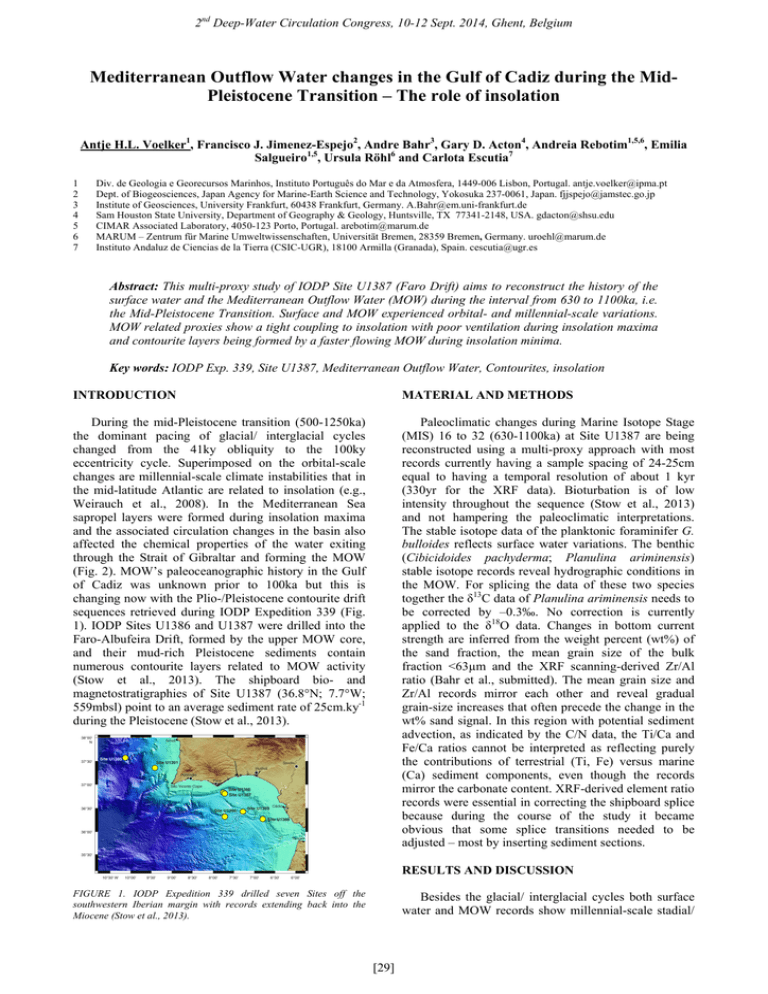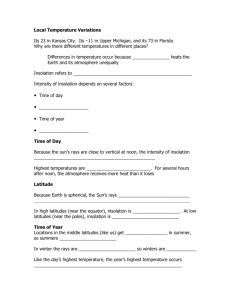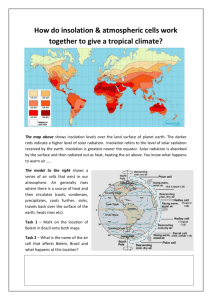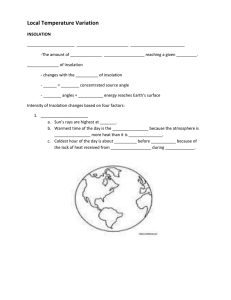Mediterranean Outflow Water changes in the Gulf of Cadiz during... Pleistocene Transition – The role of insolation
advertisement

2nd Deep-Water Circulation Congress, 10-12 Sept. 2014, Ghent, Belgium Mediterranean Outflow Water changes in the Gulf of Cadiz during the MidPleistocene Transition – The role of insolation Antje H.L. Voelker1, Francisco J. Jimenez-Espejo2, Andre Bahr3, Gary D. Acton4, Andreia Rebotim1,5,6, Emilia Salgueiro1,5, Ursula Röhl6 and Carlota Escutia7 1 2 3 4 5 6 7 Div. de Geologia e Georecursos Marinhos, Instituto Português do Mar e da Atmosfera, 1449-006 Lisbon, Portugal. antje.voelker@ipma.pt Dept. of Biogeosciences, Japan Agency for Marine-Earth Science and Technology, Yokosuka 237-0061, Japan. fjjspejo@jamstec.go.jp Institute of Geosciences, University Frankfurt, 60438 Frankfurt, Germany. A.Bahr@em.uni-frankfurt.de Sam Houston State University, Department of Geography & Geology, Huntsville, TX 77341-2148, USA. gdacton@shsu.edu CIMAR Associated Laboratory, 4050-123 Porto, Portugal. arebotim@marum.de MARUM – Zentrum für Marine Umweltwissenschaften, Universität Bremen, 28359 Bremen, Germany. uroehl@marum.de Instituto Andaluz de Ciencias de la Tierra (CSIC-UGR), 18100 Armilla (Granada), Spain. cescutia@ugr.es Abstract: This multi-proxy study of IODP Site U1387 (Faro Drift) aims to reconstruct the history of the surface water and the Mediterranean Outflow Water (MOW) during the interval from 630 to 1100ka, i.e. the Mid-Pleistocene Transition. Surface and MOW experienced orbital- and millennial-scale variations. MOW related proxies show a tight coupling to insolation with poor ventilation during insolation maxima and contourite layers being formed by a faster flowing MOW during insolation minima. Key words: IODP Exp. 339, Site U1387, Mediterranean Outflow Water, Contourites, insolation INTRODUCTION MATERIAL AND METHODS During the mid-Pleistocene transition (500-1250ka) the dominant pacing of glacial/ interglacial cycles changed from the 41ky obliquity to the 100ky eccentricity cycle. Superimposed on the orbital-scale changes are millennial-scale climate instabilities that in the mid-latitude Atlantic are related to insolation (e.g., Weirauch et al., 2008). In the Mediterranean Sea sapropel layers were formed during insolation maxima and the associated circulation changes in the basin also affected the chemical properties of the water exiting through the Strait of Gibraltar and forming the MOW (Fig. 2). MOW’s paleoceanographic history in the Gulf of Cadiz was unknown prior to 100ka but this is changing now with the Plio-/Pleistocene contourite drift sequences retrieved during IODP Expedition 339 (Fig. 1). IODP Sites U1386 and U1387 were drilled into the Faro-Albufeira Drift, formed by the upper MOW core, and their mud-rich Pleistocene sediments contain numerous contourite layers related to MOW activity (Stow et al., 2013). The shipboard bio- and magnetostratigraphies of Site U1387 (36.8°N; 7.7°W; 559mbsl) point to an average sediment rate of 25cm.ky-1 during the Pleistocene (Stow et al., 2013). Paleoclimatic changes during Marine Isotope Stage (MIS) 16 to 32 (630-1100ka) at Site U1387 are being reconstructed using a multi-proxy approach with most records currently having a sample spacing of 24-25cm equal to having a temporal resolution of about 1 kyr (330yr for the XRF data). Bioturbation is of low intensity throughout the sequence (Stow et al., 2013) and not hampering the paleoclimatic interpretations. The stable isotope data of the planktonic foraminifer G. bulloides reflects surface water variations. The benthic (Cibicidoides pachyderma; Planulina ariminensis) stable isotope records reveal hydrographic conditions in the MOW. For splicing the data of these two species together the δ13C data of Planulina ariminensis needs to be corrected by –0.3‰. No correction is currently applied to the δ18O data. Changes in bottom current strength are inferred from the weight percent (wt%) of the sand fraction, the mean grain size of the bulk fraction <63µm and the XRF scanning-derived Zr/Al ratio (Bahr et al., submitted). The mean grain size and Zr/Al records mirror each other and reveal gradual grain-size increases that often precede the change in the wt% sand signal. In this region with potential sediment advection, as indicated by the C/N data, the Ti/Ca and Fe/Ca ratios cannot be interpreted as reflecting purely the contributions of terrestrial (Ti, Fe) versus marine (Ca) sediment components, even though the records mirror the carbonate content. XRF-derived element ratio records were essential in correcting the shipboard splice because during the course of the study it became obvious that some splice transitions needed to be adjusted – most by inserting sediment sections. RESULTS AND DISCUSSION FIGURE 1. IODP Expedition 339 drilled seven Sites off the southwestern Iberian margin with records extending back into the Miocene (Stow et al., 2013). Besides the glacial/ interglacial cycles both surface water and MOW records show millennial-scale stadial/ [29] 2nd Deep-Water Circulation Congress, 10-12 Sept. 2014, Ghent, Belgium interstadial oscillations, in particular during the glacial inceptions (Fig. 2). Planktonic and benthic δ18O records are correlated on the orbital and millennial-scale level highlighting the constant exchange (en-/detrainment) between the (sub)surface waters and the MOW. Ventilation in the upper MOW core varied significantly. Low benthic δ13C values during deglacial and peak interglacial periods, coinciding with insolation maxima, reveal a poorly ventilated upper MOW core (Fig. 2) and point to a coupling between MOW ventilation and sapropel formation in the Mediterranean Sea. Better ventilation was recorded during glacial and stadial intervals, often in association with the formation of contourites. Current velocity related proxy records indicate contouritic layers occurring during interglacial and glacial periods (Fig. 2). During the warmer MIS contourite layers were not formed during the peak interglacial period, but during the stadial(s) marking the transition from the interglacial to the glacial stage. Contourites are often more pronounced during the warm than the cold (glacial) MIS but during both, contourite formation is occurring during northern hemisphere summer insolation minima (Fig. 2) revealing a direct link between upper MOW core velocity changes and cooler climate conditions. ACKNOWLEDGEMENTS The MOWCADYN (PTDC/MAR-PRO/3761/2012) project (FCT), 3 Spanish projects (CONTOURIBER, MOWER), DFG, and NSF provided financial support. REFERENCES Bahr, A., Jiménez-Espejo, F., Kolasinac, N., Grunert, P., Hernández-Molina, F.J., Röhl, U., Voelker, A., Escutia, C., Stow, D.A.V., Hodell, D., AlvarezZarikian, C.A., submitted. Deciphering bottom current strength and paleoclimate signals from contourite deposits 1 in the Gulf of Cádiz during the last 140 kyr: an inorganic geochemical approach. Geochem. Geophys. Geosyst. Lisiecki, L.E., Raymo, M., 2005. A PliocenePleistocene stack of 57 globally distributed benthic δ18O records. Paleoceanography 20, PA1003, doi: 10.1029/2004PA001071. Llave, E., Hernandez-Molina, F.J., Somoza, L., Diazdel-Rio, V., Stow, D.A.V., Maestro, A., Dias, J.M.A., 2001. Seismic stacking pattern of the FaroAlbufeira contourite system (Gulf of Cadiz): a Quaternary record of paleoceanographic and tectonic influences. Marine Geophysical Researches 22 (5-6), 487-508. Stow, D.A.V., Hernández-Molina, F.J., Alvarez Zarikian, C.A., and the Expedition 339 Scientists, 2013. Proceedings IODP Exp. 339. Tokyo (Integrated Ocean Drilling Program Management International, Inc.). doi:10.2204/iodp.proc.339.2013 Weirauch, D., Billups, K., Martin, P., 2008. Evolution of Millennial-Scale Climate Variability During the Mid Pleistocene. Paleoceanography 23, PA3216, doi: 10.1029/2007PA001584. CONCLUSIONS The new U1387 records show that climate conditions were as variable during the early to mid Pleistocene as during the late Pleistocene. Changes in the upper MOW core are tightly coupled to summer insolation with poor ventilation occurring during insolation maxima and higher current velocity marking insolation minima. This insolation forcing reveals a close coupling between MOW and Mediterranean Sea climate conditions. FIGURE 2. The Mid-Pleistocene Transition as recorded at IODP Site U1387. Panels show from top to bottom: benthic isotope stack LR04 of Lisiecki and Raymo (2005); planktonic foraminifer δ18O record for U1387, benthic foraminifer δ18O and δ13C records and at the bottom the weight-% of the sand fraction >63µm and the insolation for June 21st at 65°N. Yellow bars mark periods of poor ventilation in the upper MOW core, blue bars some of the contouritic layers. Numbers in the top panel denote Marine Isotope Stages. [30]




